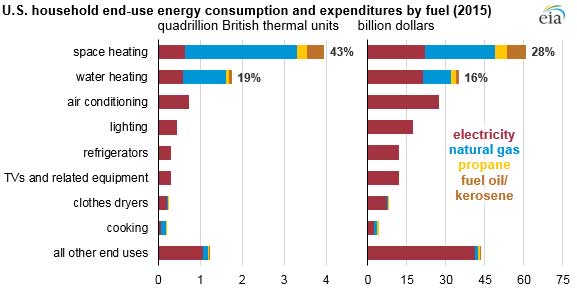Space and water heating top two energy consumers

U.S. household end-use energy consumption and expenditures by fuel (2015). Image courtesy of the Energy Information Administration
Space heating and water heating were the top two energy consumers in U.S. homes in 2015, according to the U.S. Energy Information Administration’s (EIA) latest Residential Energy Consumption Survey.
Space heating consumption can vary considerably by climate and building characteristics, while variation in water heating consumption is driven primarily by the number of occupants in a home, EIA says. Household energy consumption also varies considerably by the type of home construction. Single-family detached homes accounted for 62 percent of the occupied residential building stock in 2015, and residents in these homes consumed nearly three times more energy on average than residents living in an apartment building with five or more units, the administration reports.
In single-family detached homes, space heating was the largest end use at 46 percent. For residents living in large apartment buildings, space heating accounted for only 25 percent of consumption. According to EIA, in large apartment buildings, space heating energy usage is often lower than water heating.
The number of household members is a key determinant of energy consumption in homes, particularly for water heating, EIA says. In 2015, a two-person household consumed 12.5 million British thermal units (Btu) on average, or 16 percent of overall consumption, for water heating, according to the administration. A four-person household consumed nearly twice as much, at 22.7 million Btu per home, or 24 percent of overall consumption. The number of occupants generally has less effect on energy consumed for space heating or air conditioning.
In 2015, households paid $37.55/million Btu for electricity compared with $10.31 million/Btu for natural gas, EIA reports. While households use a mix of fuels for space and water heating, electricity is the dominant fuel for most of the remaining end uses such as air conditioning, refrigerators and lighting. Because of this, expenditures for space heating and water heating tend to be lower relative to other household end uses, accounting for 62 percent of household energy consumption in 2015, but responsible for 44 percent of household energy costs.
*Featured image: iStock.com/tttuna
















